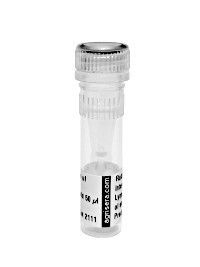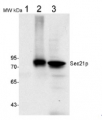1

Anti-Sar1 | Secretion-associated and Ras-related protein 1
AS08 326 | Clonality: Polyclonal | Host: Rabbit | Reactivity: A. thaliana, D. sanguinalis, Echinochloa crus-galli E. neomexicana, P. miliaceum, P. maximum, P. vittata, T. aestivum, Z. mays
- Product Info
-
Immunogen: GST fusion of full length recombinant Sar1 of Arabidopsis thaliana UniProt: Q8VYP7, TAIR: At3g62560
Host: Rabbit Clonality: Polyclonal Purity: Serum Format: Lyophilized Quantity: 100 µl Reconstitution: For reconstitution add 100 µl of sterile water Storage: Store lyophilized/reconstituted at -20°C; once reconstituted make aliquots to avoid repeated freeze-thaw cycles. Please remember to spin the tubes briefly prior to opening them to avoid any losses that might occur from material adhering to the cap or sides of the tube. Tested applications: Immunogold (IG), Western blot (WB) Recommended dilution: 1 : 50 (IG), 1 : 500 (WB) Expected | apparent MW: 21 kDa (Arabidopsis thaliana)
- Reactivity
-
Confirmed reactivity: Arabidopsis thaliana, Echinochloa crus-galli Eragrostis neomexicana, Digitaria sanguinalis, Pteris vittata (fern), Panicum miliaceum, Panicum maximum, Petunia hybrida, Triticum aestivum, Zea mays Predicted reactivity: Brachypodium distachyon, Brassica campestris, Brassica napus, Brassica rapa, Capsella rubella, Citrus clementina, Glycine max, Hordeum vulgare, Medicago truncatula, Oryza sativa, Populus trichocarpa, Populus trichocarpa, Ricinus communis, Solanum lycopersicum, Solanum tuberosum, Sorghum bicolor, Theobroma cacao, Triticum aestivum, Vitis vinifera
Species of your interest not listed? Contact usNot reactive in: Nicotiana tabacum
- Additional Information
-
Additional information: For immunogold experiments plant tissue has been fixed with GA in PFA/PIPES. LR White resin has been used. Tested species were: Triticum aestivum, Panicum miliaceum, Panicum maximum, Echinochloa crus-galli Eragrostis neomexicana, Digitaria sanguinalis. Publication in preparation.
Additional information (application): Immunolocalization method with Sar1 antibodies is described in: Yao-dong Yang (2005). Dynamics of COPII vesicles and the Golgi apparatus in cultured Nicotiana tabacum BY-2 cells provides evidence for transient association of Golgi stacks with endoplasmic reticulum exit sites. Plant Cell. 2005 May;17(5):1513-31. Epub 2005 Apr 1. - Background
-
Background: Sar1 belongs to a small GTPase superfamily and GTP binging activity. This protein is involved in intracellular protein transport. There are two different non-clathrin-coated vesicles that are responsible for transport between ER and the Golgi. Coat protein complexes involving membrane-associated GTP binging proteins – Arf1 and Sar1p for COPI and COPII are needed for formation of COP-coated vesicles. Sar1p is a cytosolic protein. It is temporarily recruited onto the membranes of the ER.
- Product Citations
-
Selected references: Shen et al. (2014). The fronds tonoplast quantitative proteomic analysis in arsenic hyperaccumulator Pteris vittata L. J Proteomics. 2014 Feb 4. pii: S1874-3919(14)00047-5. doi: 10.1016/j.jprot.2014.01.029.
Liu et al. (2014). SCFSLF-mediated cytosolic degradation of S-RNase is required for cross-pollen compatibility in S-RNase-based self-incompatibility in Petunia hybrida. Front. Genet., 22 July 2014 | doi: 10.3389/fgene.2014.00228 - Protocols
-
Agrisera Western Blot protocol and video tutorials
Protocols to work with plant and algal protein extracts
Oxygenic photosynthesis poster by prof. Govindjee and Dr. Shevela
Z-scheme of photosynthetic electron transport by prof. Govindjee and Dr. Björn and Dr. Shevela - Reviews:
-
| 2009-07-21This antibody was able to detect Sar1 in the fern Pteris vittata. I used the recommended dilution of 1:500 and incubated the antibody for at least 8 hours at room temp (22 deg). It worked very well!
Accessories

AS08 327 | Clonality: Polyclonal | Host: Rabbit | Reactivity: Arabidopsis thaliana, Zea mays | Cellular [compartment marker] of Golgi in immunolocalization and of COP1 in western blot


